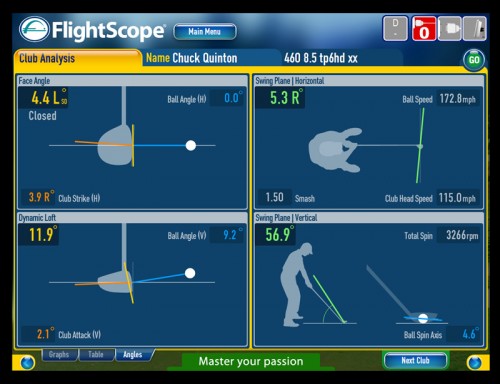FlightScope has come a long way in the development of their launch monitor that we use here for our fittings at the Rotary Swing Golf Academy. Now, it has become an invaluable instruction tool that I am currently using to optimize my swing for ideal launch conditions here in Colorado where I spend the summer. No longer are you guessing when your path or plane is optimal or worse yet, working on something that’s not broken in your swing. For instance, as you’ll see, with my driver my path tends to be too far in to out. My tendency is to hit a push draw and miss with a big block and the occasional shot that looks like a dead pull – which would indicate an out to in path with the naked eye. However, using the new wireless FlightScope Prime today at the range, never once was my path out to in, even though I hit a few shots that would easily fool you into thinking that I did. These shots started just left of my line and drew further to the left. The reality is that this was all due to clubface angle at impact.
Let’s take a closer look at this data and see just how incredibly efficient working on your swing can be using the FlightScope Prime.

Chuck Quinton Driver and Swing Parameters
Starting in the top left corner, we can see that my clubface angle was 4.4 closed in relation to my swing path which was 3.9* in to out at impact. However, you can see that this created a ball that started out at 0.0*, or dead on my intended target line. The next box over to the right shows the Horizontal swing plane at the bottom of my swing arc of 5.3* in to out. In other words, at the moment my club is traveling level to the ground, I’m swinging in to out 5.3*. This is something that I’m working hard to correct to get closer to 0 degrees, but right now I average 6.6*.
In the bottom left box, we can see Dynamic Loft – or the effective loft you had at impact due to clubface loft, shaft flexing and where you strike the ball on the face. The dynamic loft of 11.9* is due to my using an 8.5* Nakashima Htec 460 head with the Matrix TP6HD XX flex shaft. My path is slightly positive at 2.1* which is quite ideal for me, however my launch angle on this particular shot was 9.2*, or LESS than the dynamic loft. This is due to the ball compressing on the face (these shots were with Callaway range balls) as well as a matter I’ll discuss in the next section. I have seen that premium balls tend to launch even lower than this in relation to the Dynamic Loft due to the fact that they tend to compress more.
Lastly is the Vertical Swing Plane. This is the angle of the Swing Plane at impact. This is too upright for me and is creating the excessive in to out path. By bringing this down closer to 50* or less will allow me to bring my path closer to 0. Also in this box are the total spin numbers of 3266 rpms and the Ball Spin Axis of positive 4.6*. This high spin rate and low launch angle makes it very clear what happened here – I hit this ball low on the face. The Ball Spin Axis of 4.6 degrees means that this ball was spinning on axis tilted to the right that created the slight fade that I hit on this shot. Now, if you’ve been following along closely, you should be wondering how on earth did a ball that was hit with a 4.4* shut face on an into out path start on line and this FADE??? Conventional wisdom would say that this should be a pull draw and you’d be correct in assuming that. However, we’ve failed to consider one last ultra vital component that will now glue all the pieces of the puzzle together for this complex set of parameters – where was the ball struck on the face?
That answer is that this shot was struck on the heel – and low on the heel. You see, according to David Nel, one of the experts at FlightScope, missing the sweetspot on the driver by as little as 1/2″ inch can tilt the Spin Axis as much as 20* creating a shot that will go wildly off line even if the path and face angle are dead square!!! Sort of makes you wonder how we ever hit the ball straight?
Needless to say, this type of information is simply incredibly useful not just for fitting you in the best driver we can, but also for helping build your swing into an efficient ball striking machine! For more information on FlightScope Prime, visit www.FlightScope.com and for information about being fitted by me at the RSGA, visit here for FlightScope Launch Monitor fittings.















